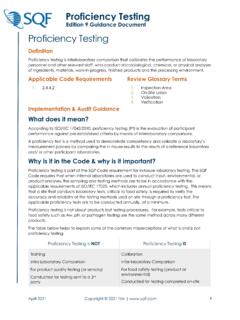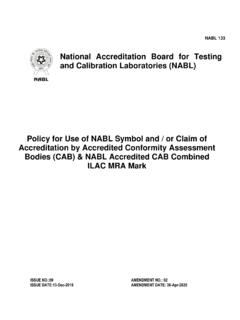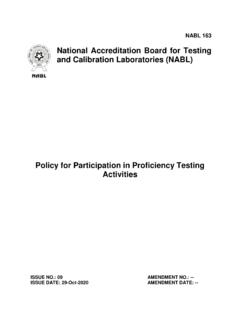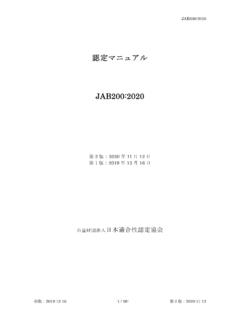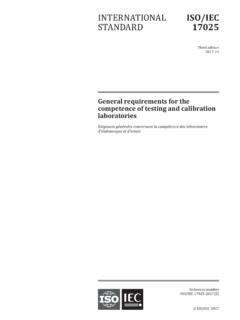Transcription of ISO/IEC 17043:2010(E) ISO/IEC 17043
1 ISO/IEC 17043 :2010(E) ISO/IEC 17043 First edition 2010-02-01 Conformity assessment General requirements for proficiency testing ISO/IEC 17043 :2010(E) Contents Page Foreword ..iv 1 2 Normative 3 Terms and definitions ..1 4 Technical Requirements ..4 General ..4 Personnel ..4 Equipment, accommodation and environment ..5 Design of proficiency testing Choice of method or Operation of proficiency testing Data analysis and evaluation of proficiency testing scheme results ..12 Reports ..13 Communication with 5 Management Management system ..16 Document Review of requests, tenders and Subcontracting Purchasing services and supplies.
2 19 Service to the Complaints and appeals ..20 Control of nonconforming work ..20 Improvement ..20 Corrective actions ..21 Preventive Control of records ..22 Internal audits ..22 Management reviews ..23 Annex A (informative) Types of proficiency testing schemes ..24 Annex B (informative) Statistical methods for proficiency Annex C (informative) Selection and use of proficiency ISO/IEC 17043 :2010(E) Foreword ISO (the International Organization for Standardization) and IEC (the International Electrotechnical Commission) form the specialized system for worldwide standardization. National bodies that are members of ISO or IEC participate in the development of International Standards through technical committees established by the respective organization to deal with particular fields of technical activity.
3 ISO and IEC technical committees collaborate in fields of mutual interest. Other international organizations, governmental and non-governmental, in liaison with ISO and IEC, also take part in the work. In the field of conformity assessment, the ISO Committee on conformity assessment (CASCO) is responsible for the development of International Standards and Guides. International Standards are drafted in accordance with the rules given in the ISO/IEC Directives, Part 2. Draft International Standards are circulated to the national bodies for voting. Publication as an International Standard requires approval by at least 75 % of the national bodies casting a vote. Attention is drawn to the possibility that some of the elements of this document may be the subject of patent rights.
4 ISO shall not be held responsible for identifying any or all such patent rights. ISO/IEC 17043 was prepared by the ISO Committee on conformity assessment (CASCO). It was circulated for voting to the national bodies of both ISO and IEC, and was approved by both organizations. This first edition of ISO/IEC 17043 cancels and replaces ISO/IEC Guide 43-1:1997 and ISO/IEC Guide 43-2:1997, which have been technically revised. ISO/IEC 17043 :2010(E) Introduction Interlaboratory comparisons are widely used for a number of purposes and their use is increasing internationally. Typical purposes for interlaboratory comparisons include: a) evaluation of the performance of laboratories for specific tests or measurements and monitoring laboratories' continuing performance; b) identification of problems in laboratories and initiation of actions for improvement which, for example, may be related to inadequate test or measurement procedures, effectiveness of staff training and supervision, or calibration of equipment; c) establishment of the effectiveness and comparability of test or measurement methods; d) provision of additional confidence to laboratory customers; e) identification of interlaboratory differences.
5 F) education of participating laboratories based on the outcomes of such comparisons; g) validation of uncertainty claims; h) evaluation of the performance characteristics of a method often described as collaborative trials; i) assignment of values to reference materials and assessment of their suitability for use in specific test or measurement procedures; and j) support for statements of the equivalence of measurements of National Metrology Institutes through key comparisons and supplementary comparisons conducted on behalf of the International Bureau of Weights and Measurement (BIPM) and associated regional metrology organizations. Proficiency testing involves the use of interlaboratory comparisons for the determination of laboratory performance, as listed in a) to g) above.
6 Proficiency testing does not usually address h), i) and j) because laboratory competence is assumed in these applications, but these applications can be used to provide independent demonstrations of laboratory competence. The requirements of this International Standard can be applied to many of the technical planning and operational activities for h), i) and j). The need for ongoing confidence in laboratory performance is not only essential for laboratories and their customers but also for other interested parties, such as regulators, laboratory accreditation bodies and other organizations that specify requirements for laboratories. ISO/IEC 17011 requires accreditation bodies to take account of laboratories' participation and performance in proficiency testing.
7 There is a growing need for proficiency testing for other conformity assessment activities, such as inspection or product certification. Most of the requirements in this International Standard apply to those evolving areas, especially regarding management, planning and design, personnel, assuring quality, confidentiality, and other aspects, as appropriate. This International Standard has been prepared to provide a consistent basis for all interested parties to determine the competence of organizations that provide proficiency testing. In doing so it replaces both parts of ISO/IEC Guide 43:1997. ISO/IEC Guide 43 included not only guidance on development and operation of proficiency testing and selection and use of proficiency testing by laboratory accreditation bodies, but also useful descriptions of typical types of proficiency testing.
8 This International Standard has preserved and updated the principles for the operation of proficiency testing described in ISO/IEC Guide 43 and has retained in Annexes A to C information on typical types of proficiency testing schemes, guidance on appropriate statistical methods, selection and use of proficiency testing schemes by laboratories, accreditation bodies, regulatory bodies, and other interested parties. ISO/IEC 17043 :2010(E) 1 / 39 Conformity assessment General requirements for proficiency testing 1 Scope This International Standard specifies general requirements for the competence of providers of proficiency testing schemes and for the development and operation of proficiency testing schemes.
9 These requirements are intended to be general for all types of proficiency testing schemes, and they can be used as a basis for specific technical requirements for particular fields of application. 2 Normative references The following referenced documents are indispensable for the application of this document. For dated references, only the edition cited applies. For undated references, the latest edition of the referenced document (including any amendments) applies. ISO/IEC 17000:2004, Conformity assessment Vocabulary and general principles ISO/IEC Guide 99:2007, International vocabulary of metrology Basic and general concepts and associated terms (VIM) 3 Terms and definitions For the purposes of this document, the terms and definitions given in ISO/IEC 17000:2004, ISO/IEC Guide 99:2007 and the following apply.
10 Assigned value value attributed to a particular property of a proficiency test item coordinator one or more individuals with responsibility for organizing and managing all of the activities involved in the operation of a proficiency testing scheme customer organization or individual for which a proficiency testing scheme is provided through a contractual arrangement interlaboratory comparison organization, performance and evaluation of measurements or tests on the same or similar items by two or more laboratories in accordance with predetermined conditions ISO/IEC 17043 :2010(E) 2 / 39 outlier observation in a set of data that appears to be inconsistent with the remainder of that set NOTE An outlier can originate from a different population or be the result of an incorrect recording or other gross error.



